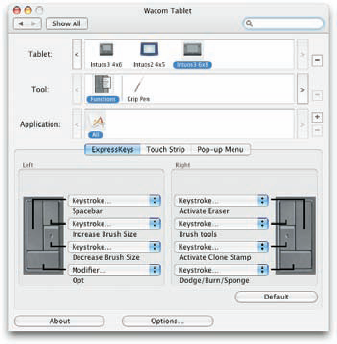Considering reasons to use a tablet
Setting up your tablet for efficient Photoshop work
Drawing tablets from Wacom enable you to use a special stylus, which you hold like a pen or pencil or brush, to move the cursor (rather than using a mouse, track pad, or trackball). There are several reasons why using a stylus is a huge improvement over a mouse, and I give you five to start off the chapter. Another five reasons you'll love your Wacom tablet involve maximizing your efficiency; those reasons conclude the chapter.

Whether you use a pen only to sign your name or you're a traditionally trained artist, the movement of a stylus is far more natural than pushing a mouse around a desk.
Use of a drawing tablet instead of a mouse can help avoid repetitive stress injuries and carpal tunnel syndrome, and can be vastly more comfortable for those of us who suffer from arthritis and tendonitis.
With up to 1,024 levels of sensitivity, a "click" or a "drag" using a drawing tablet is far more versatile than working with a mouse. Open the Photoshop Brushes palette and take a look at the eight different options that you can control through Pen Pressure, Pen Tilt, or (with the Wacom Airbrush) Stylus Wheel (see Figure 19-1). And don't forget about tools that can be directly controlled with pen pressure, such as the Quick Selection tool, which can use pen pressure to adjust the brush diameter.
You can lean back and relax or sit up straight: With fingers poised over the keyboard or hand grasping mouse, you're pretty much locked into a single position, often for hours at a time. With the long cord of a Wacom tablet plugged into a handy USB port, you have the flexibility to change positions, move back from the monitor, even slouch in a way that would make Mom turn pale — all while still sending input to the computer. Whether you work with the tablet on the desk or on your lap, it doesn't matter; do whatever is most comfortable and efficient for you.
How about convenient controls, right on the tablet, that let you access modifier keys, keyboard shortcuts, and even brush sizes and tool selection? No need to lean back in toward the desk to press a key or two; just program your most-needed keystrokes to the tablet.
The inexpensive Bamboo and Bamboo Fun come in two sizes (just under 4 × 6 and 5.3 × 8.5 inches for the working areas) and have 512 levels of pressure sensitivity. The professional Intuos line includes six different sizes, from 4 × 6 to a whopping 12 × 19 inches. The 12 × 19–inch and 8 × 11–inch sizes are specifically designed for widescreen and dual-monitor systems. If you have a fine-arts background, you might want a larger tablet. If you are not a traditionally-trained artist, you might be more comfortable with a smaller tablet, on which you can make smaller strokes. Regardless of what size tablet you have, don't forget that you can zoom in on a specific area of your image while you work. (And keep in mind that you might also want to have a smaller tablet to slide right into your laptop case, too.)
Most (but not all) Wacom pens have a switch, called the DuoSwitch, right on the side that (by default) lets you right-click or double-click simply by rocking the switch. Rather than tapping the pen twice on the tablet to double-click (which could leave two spots of color if the Brush tool is active), simply press the DuoSwitch's upper rocker. And, of course, you can program the DuoSwitch to other functions as well, such as a specific keystroke, a modifier key, even panning and scrolling.
After downloading and installing the latest version of the Wacom driver for your tablet, open the Control Panel and customize your tablet. (On a Mac, choose System Preferences
Wacom offers a variety of pens, several different kinds of mouse (including a five-button model), and even an airbrush to help you get the very most out of your tablet. Choose the input device that's best for you — or switch among several, using the one that's most appropriate for the specific job at hand.
The ultimate tablets are, of course, the Cintiq tablets, which integrate a monitor into the tablet, enabling you to paint or draw directly on your image. Wacom offers Cintiqs in both 12" and 21" (measured diagonally). And although $999 to $1,999 may seem like a lot of money for a tablet, it's not too extreme when you consider the money you may save by not purchasing a monitor. Whether you use the integrated stand and paint on your Cintiq on your desk (see Figure 19-3) or take advantage of the long cable and work with the display in your lap, you're bound to find increased accuracy and productivity at your fingertips — literally!
Note
Until you're perfectly comfortable using a stylus and tablet, the Cintiq line might be a bit of a stretch. But after you've worked with the more affordable lines of tablets (Intuos, Graphire, and the entry-level Bamboo), you may develop a craving for a Cintiq!



